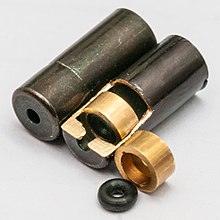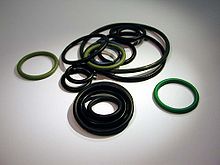Seal (technology)

In technology, a seal is used to describe elements or structures that have the task of preventing or limiting unwanted material transfers from one place to another.
If, for example, a shut-off water tap is still dripping, its seal is defective. In the case of an air-filled vehicle tire, the valve seal closes after inflation in order to prevent a pressure drop due to the escape of gas .
In addition to the contact seals, there are also non-contact seals as a special case . Depending on the type of relative movement of the parts to be sealed against each other, a distinction is made between static (no movement), translatory (straight movement) and rotary (rotating movement) seals.
If the sealing gap is filled with a special material, such as an elastic or wear-resistant hardened material, the contact surfaces are referred to as a sealing seat or, for short, a sealing seat . Even if, for example, with valves and other shut-off fittings, a movable shut-off element is moved into a form- fitting counterpart to seal the opening , this is referred to as a sealing seat .
Contact seals
The sealing elements touch each other. They represent the largest group of seals.
Static seals

The sealing elements do not perform any relative movement.
- Flat gasket - They represent a particularly extensive area in terms of the selection of materials and the size of the connection points of z. B. pipelines .
- Profile seal or lip seal, about the so-called dry glazing for the sealing of the glass pane in the window frame
- Socket seal
- Roller seal
- integral seals (gluing, soldering, welding)
- Sealing compound ( putty , bitumen , silicone , PU )
- Sealing clamp
- Grinding-in seal
- Press connection ( osculation seals )
Examples:
- Delta ring
- O-ring
- Fiber seal
- Compriband
- Inflatable seal (ABD) or inflatable clamp, inflatable cuff, etc.
Dynamic seals
The sealing elements move relative to one another.
Translational seals
The sealing elements perform a linear sliding movement to one another.
Rotary seals
The relative movement of the sealing elements is rotary. The typical application is the sealing of a rotating shaft against a stationary housing.
- Stuffing box
- Radial shaft seal (for low pressure applications)
- Axial shaft seal (for subordinate sealing tasks)
- Mechanical seal (suitable for high pressures up to 300 bar)
- Brush seal
- Shaft lip seal.
Open and close
The sealing elements have alternating contact, but do not move or move only slightly with respect to one another (for example when a sealing lip moves a little between the first contact and the rest position).
- Profile seal or lip seal for modern door and window wings
- Felt or foam sealing tape for retrofitting door and window sashes
- Sealing disc, sealing cone or sealing cone for valves ; wedge-shaped sealing body for gate valves

Contactless seals
Contactless seals are mainly used for sealing surfaces that can move relative to one another.
- Pressure and throttle seals:
- Labyrinth seal
- Magnet-fluid seal
- Chamber seal
- Sealing air (e.g. in department store entrances)
- Barrier liquid for an odor trap
- Mass force seals:
- Sling disc
- Splash ring
- Labyrinth seal
- Viscosity seals:
-
Shaft seals
- Threaded shaft seal
- Radial shaft seal (at high speed)
-
Shaft seals
Apart from the magnetic-fluid seal, its sealing is not perfect, but only limiting, since a small free gap cross-section remains.
See also
literature
- Trade magazine "DICHT! - Trialogue of sealing, adhesive and polymer technology. ISSN 1863-4699 .
- Karl F. Berger and Sandra Kiefer: Seal Technology Yearbook 2018. ISBN 978-3-946260-01-1 .
- SKF Catalog 4006 / IG: CR seals
- Parker Prädifa: O-ring manual
- Gerhard P. Streit et al .: Elastomer sealing systems - materials, applications, constructions, standards . Expert-Verlag 2010, ISBN 978-3-8169-2895-9
- Eberhard Braun: Technical rules for the planning and execution of seals . Structural areas in contact with the ground above the water table. In: Federal Department of Building Sealing (BFA BWA) in the Main Association of the German Building Industry eV (Hrsg.): BWA - guidelines for building sealing . tape 1 . Otto Elsner Verlagsgesellschaft, Dieburg 2004, ISBN 3-87199-171-6 ( table of contents and index [PDF; accessed on February 19, 2014]).
- Herbert Ehbrecht: Technical rules for the planning and execution of seals . against external pressing water. In: Federal Department of Building Sealing (BFA BWA) in the Main Association of the German Building Industry eV (Hrsg.): BWA - guidelines for building sealing . tape 2 . Otto Elsner Verlagsgesellschaft, Dieburg 2006, ISBN 3-87199-172-4 ( table of contents and index [PDF; accessed on February 19, 2014]).
- Michael Herres, Georg Göker: Technical rules for the planning and execution of seals . of parking decks, courtyard cellar ceilings and similar constructions. In: Federal Department of Building Sealing (BFA BWA) in the Main Association of the German Building Industry eV (Hrsg.): BWA - guidelines for building sealing . tape 3 . Otto Elsner Verlagsgesellschaft, Dieburg 2010, ISBN 3-87199-173-2 ( index and index [PDF; accessed on February 19, 2014]).
Web links
- Script Sealing Technology IMA Uni Stuttgart (PDF, 4.5 MB)
- Database with current characteristic values according to EN 13555 for flat gaskets
- Technical manual for sealing and vibration technology
- Online specialist book on sealing technology
- Worth knowing in the area of sealing technology, market studies, checklists, surveys, price index, material compass >> ISGATEC network
Individual evidence
- ↑ Installation accessories for the Rohloff Speedhub 500/14 gear hub
